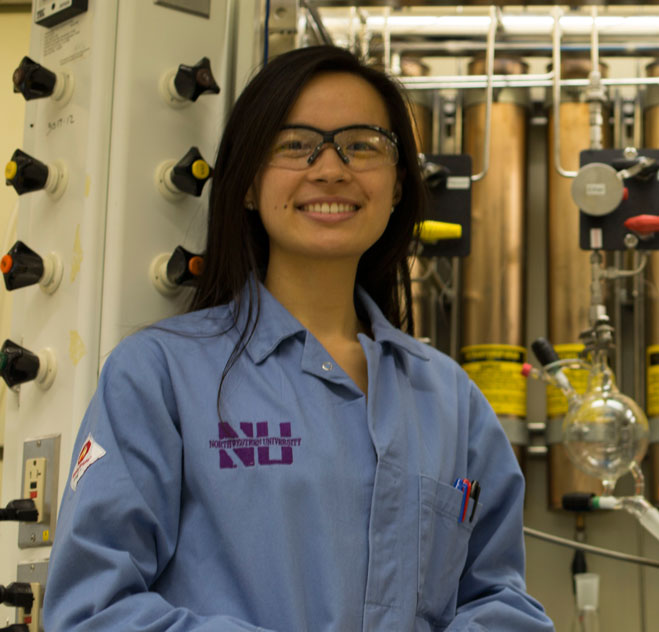Chemical & Engineering News —
The chemical industry can take several approaches to build a dynamic and diverse 21st-century workforce.
Andrea d’Aquino did not have a home computer while growing up in Bellingham, Wash. Rather than let that stop her, she spent hours in the school library researching how to fund her education.

Andrea d’Aquino. (Northwestern Now)
“I come from a very big family, and no one had gone on to higher education,” says d’Aquino. “No one could quite tell me how you pay for college or get into college.” Fortunately, she won a scholarship from the Gates Millennium Scholars Program and undertook her undergraduate studies at Western Washington University.
Alicia McGeachy was also the first member of her family to receive a degree, which she achieved though the same determination and resourcefulness. McGeachy went to a large school in Brooklyn, N.Y. “The teachers were supportive, but they didn’t have a lot of time,” she explains. Her father encouraged her to help herself. She did her research and, with that in hand, went on to secure scholarships for Spelman College in Atlanta.
McGeachy and d’Aquino faced the kind of hurdles many college students never have to contemplate, but they overcame them, and now both are graduate students at Northwestern University. McGeachy is researching how nanotechnology can mitigate the health and environmental effects from batteries, such as those from cars and laptops. D’Aquino intends to apply her knowledge in organometallic supramolecular chemistry to help answer questions about energy, the environment, and health.
D’Aquino and McGeachy believe that encouraging more diverse perspectives throughout science, technology, engineering, and mathematics (STEM) education and industries will help us find innovative solutions to society’s most pressing global challenges, from finding clean energy alternatives to discovering new ways to make chemical manufacturing sustainable. McGeachy, as a black American woman, and d’Aquino, as an Asian American woman, drew on their experiences when they set up Northwestern University Building on Diversity (NUBonD) to foster “inclusivity and diversity of thought, ideas, and backgrounds” within chemistry.

Alicia McGeachy. Recipient of the 2017 The Graduate School (TGS) Diversity Award recognizing her outstanding contributions to NU.
“I don’t think people necessarily connect the importance of diversity with chemistry,” McGeachy says. “People don’t see how it changes things, but even the questions we ask and how we ask them and the communities we impact—that is all driven by our own perspectives.”
McGeachy and d’Aquino’s work is sorely needed. In a 2015 report titled “Reaching the Full Potential of STEM for Women and the U.S. Economy,” the U.S. Chamber of Commerce Foundation notes that the U.S. will need to fill 6.6 million STEM jobs over the next 10 years. However, women account for just 25% of workers in STEM fields. A 2016 fact sheet published by the U.S. Department of Education notes that from 2008 to 2013, African Americans received just 7.6% of all STEM bachelor’s degrees.
“A diverse workforce keeps our perspectives fresh and our ideas innovative.”Reaching the Full Potential of STEM for Women and the U.S. Economy,
U.S. Chamber of Commerce Foundation
Diversity in the workforce is important because it brings greater perspective to the questions that industry can ask and the solutions it devises. The Chamber of Commerce Foundation report neatly sums it up: “A diverse workforce keeps our perspectives fresh and our ideas innovative.”
As a volunteer STEM teacher, d’Aquino has witnessed firsthand how young girls and underrepresented minority students often “self-select out of science.” She notes that it’s important “to target young girls and underrepresented minorities at a young age and to encourage them to pursue science,” adding that they need to be told that they can be leaders.
Industry could support the diversification of the talent pool by making it more reflective of the population. By nurturing future chemists throughout their K–12 education, not just at the college or postgraduate level, industry can become more inclusive, according to Stephanie Rogers, managing director for Accenture’s resources industry group. She notes that the chemical industry can improve its attractiveness to STEM graduates—something that’s sorely needed. Accenture partnered with the trade association American Chemistry Council to conduct a survey, which showed that only 30% of chemistry-related graduates are working in the chemical industry.
Rogers says companies can create “targeted talent strategies that both support the chemical companies’ business model and translate these needs to reflect a career path that is interesting and attractive to the current and future workforces.” For example, to attract, retain, and nurture female (and, increasingly, male) talent, Rogers suggests promoting flexible work schedules that support child care, aging parents care, and parental leave.
Duane Dickson, vice chair and global and U.S. chemicals and specialty materials sector leader for Deloitte, thinks that the chemical industry ought to be more responsive to changing attitudes. “One of the big things we’ve found is that this generation’s STEM talent looks for employers who give them the ability to solve problems important to society,” he explains. Rogers agrees, saying chemical companies could “make a good case for how the industry is contributing to resolving a host of challenges, from feeding growing populations to enabling reduced energy consumption.”
MAKING CAREER CHOICES
Like other graduate students, McGeachy and d’Aquino are contemplating what they will do once they’ve earned their degrees. Emily Weiss, Northwestern professor of chemistry and of material science and engineering, advises industry to seek the best talent early. “Students are extremely goal oriented these days and thinking about their postgraduate plans earlier,” Weiss says. “If companies want these types of students, I think they need to go after them in their first and second years.”
Besides attracting talent, companies also should have ways to retain talent.
To choose a career in industry, McGeachy says she’d be attracted to public-facing positions in companies that emphasize closer interactions with communities. She encourages industry recruiters to talk about managerial, as well as laboratory, positions when meeting with students. For d’Aquino, it is about having more opportunities to experience industry. “This may be through internship programs, collaborative projects, or even just student site visits,” she says.
Models for industry-academic partnerships do exist. At Northwestern, students have access to a Management for Scientists & Engineers training course offered by Kellogg School of Management and can take part in internships through Northwestern’s Innovation & New Ventures Office. They can also attend Industrial Associates events, where graduate students and industry representatives can interact. Co-op programs are a staple of major engineering programs nationwide.

Alicia McGeachy at the Museum of Science and Industry.
Read more: Northwestern TGS Spotlight: Alicia McGeachy: Finding Balance between Science and Outreach
To choose a career in industry, McGeachy says she’d be attracted to public-facing positions in companies that emphasize closer interactions with communities. She encourages industry recruiters to talk about managerial, as well as laboratory, positions when meeting with students. For d’Aquino, it is about having more opportunities to experience industry. “This may be through internship programs, collaborative projects, or even just student site visits,” she says.
Models for industry-academic partnerships do exist. At Northwestern, students have access to a Management for Scientists & Engineers training course offered by Kellogg School of Management and can take part in internships through Northwestern’s Innovation & New Ventures Office. They can also attend Industrial Associates events, where graduate students and industry representatives can interact. Co-op programs are a staple of major engineering programs nationwide.
Besides attracting talent, companies also should have ways to retain talent. McGeachy explains that she would be inclined to stick with a company that offered a fast-paced and flexible working environment. “I think it would also help if I were part of a company that truly valued my opinion and the opinions and needs of all their constituents,” she adds.
The industry can retain talent by promoting a sense of employee ownership of projects and encouraging professional development opportunities. As female graduates progress through their careers, ensuring that inspiring role models are visible in the company also keeps a working environment attractive. “Another big signal to midcareer and senior leaders is the visual sign of women being part of the leadership team, including the board of directors,” Rogers says.”
A DIVERSE AND INNOVATIVE FUTURE
D’Aquino and McGeachy represent the future of STEM because they have clear goals and want to contribute to society. To build a dynamic workforce, the chemical industry can listen to, support, and actively court talent such as theirs.
Through their work with NUBonD, d’Aquino and McGeachy are opening discourse on the power of diversity. They invite scientists from different backgrounds to discuss the issue of diversity and consider how it affects their research. By encouraging diversity in STEM—from the classroom to the boardroom—the chemical industry can gain the breadth of perspective that is needed in a rapidly changing world. As d’Aquino says, “You can only be better with more diversity.”
[Top image: Chemist with beaker. Steve Cole/iStock]

Susan Kelliher, Senior Vice President, Human Resources, Chemours
Read more on how Chemours nurtures talent at: Chemours.com/nuturing-talent.
[This sponsored content feature has been produced with support from The Chemours Company. Sponsored content is not written by and does not necessarily reflect the views of C&EN’s editorial staff. It is authored by writers approved by the C&EN BrandLab and held to editorial standards expected in C&EN magazine stories, with the intent of providing valuable information to C&EN readers.]









